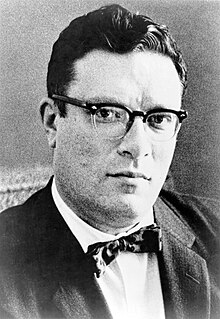
Isaac Asimov was an American writer and professor of biochemistry at Boston University. During his lifetime, Asimov was considered one of the "Big Three" science fiction writers, along with Robert A. Heinlein and Arthur C. Clarke. A prolific writer, he wrote or edited more than 500 books. He also wrote an estimated 90,000 letters and postcards. Best known for his hard science fiction, Asimov also wrote mysteries and fantasy, as well as much nonfiction.

Stanisław Herman Lem was a Polish writer of science fiction and essays on various subjects, including philosophy, futurology, and literary criticism. Many of his science fiction stories are of satirical and humorous character. Lem's books have been translated into over 50 languages and have sold over 45 million copies. Worldwide, he is best known as the author of the 1961 novel Solaris. In 1976 Theodore Sturgeon wrote that Lem was the most widely read science fiction writer in the world. Lem's science fiction works explore philosophical themes through speculations on technology, the nature of intelligence, the impossibility of communication with and understanding of alien intelligence, despair about human limitations, and humanity's place in the universe. His essays and philosophical books cover these and many other topics.

Foundation is a science fiction novel by American writer Isaac Asimov. It is the first published in his Foundation Trilogy. Foundation is a cycle of five interrelated short stories, first published as a single book by Gnome Press in 1951. Collectively they tell the early story of the Foundation, an institute founded by psychohistorian Hari Seldon to preserve the best of galactic civilization after the collapse of the Galactic Empire.
"The Bicentennial Man" is a novelette in the Robot series by American writer Isaac Asimov. According to the foreword in Robot Visions, Asimov was approached to write a story, along with a number of other authors who would do the same, for a science fiction collection to be published in honor of the United States Bicentennial. However, the arrangement fell through, leaving Asimov's the only story actually completed for the project. Asimov sold the story to Judy-Lynn del Rey, who made some small changes to the text. Asimov restored the original text when the story was collected in The Bicentennial Man and Other Stories (1976).
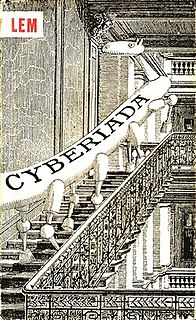
The Cyberiad is a series of humorous science fiction short stories by Polish writer Stanisław Lem, originally published in 1965, with an English translation appearing in 1974. The main protagonists of the series are Trurl and Klapaucius, the "constructors".
In Isaac Asimov's robot novels, Frankenstein complex is a term he coined for the fear of mechanical men.
"Let's Get Together" is a science fiction short story by American writer Isaac Asimov. It was originally published in the February 1957 issue of Infinity Science Fiction, and included in the collections The Rest of the Robots (1964) and The Complete Robot (1982). The robots in this tale are very different from Asimov's norm, being quite willing to work as war machines. The tale is also based on a continuation of Cold War hostility, rather than the peaceful unified world of most of the robot stories.
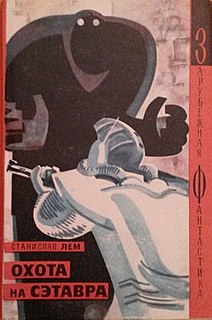
Tales of Pirx the Pilot is a science fiction stories collection by Polish author Stanisław Lem, about a spaceship pilot named Pirx.
"The Last Answer" is a science fiction short story by American writer Isaac Asimov. It was first published in the January 1980 issue of Analog Science Fiction and Fact, and reprinted in the collections The Winds of Change and Other Stories (1983), The Best Science Fiction of Isaac Asimov (1986), and Robot Dreams (1986).
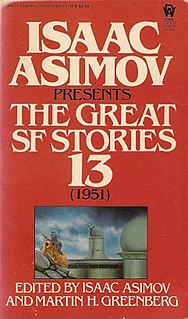
Isaac Asimov Presents The Great SF Stories 13 (1951) is a collection of science fiction short story, edited by Isaac Asimov and Martin H. Greenberg, part of a series that which attempts to list the great science fiction stories from the Golden Age of Science Fiction. They date the Golden Age as beginning in 1939 and lasting until 1963. It was the first book in the series to not be reprinted as part of the Isaac Asimov Presents The Golden Years of Science Fiction series. This volume was originally published by DAW books in July 1985.

The Golden Age of Science Fiction is an anthology of science fiction short stories all originally published between 1949 and 1962. The stories were selected and introduced by Kingsley Amis, who also wrote an Editor's Note and a 21-page Introduction. The collection was first published by Hutchinson in 1981 and was released in paperback by Penguin in 1983.

A human disguise is a concept in fantasy, folklore, mythology, religion, literary tradition, iconography, and science fiction whereby non-human beings such as aliens, angels, demons, gods, monsters, robots, Satan, or shapeshifters are disguised to seem human. Stories have depicted the deception as a means used to blend in with people, and science fiction has used the dichotomy to raise questions about what it means to be human.
Franz Rottensteiner is an Austrian publisher and critic in the fields of science fiction and speculative fiction in general.
Mad scientists and inventors appear in the fiction of Stanisław Lem in the memoirs of Lem's starfaring vagabond Ijon Tichy, collected in The Star Diaries and Memoirs of a Space Traveller, as well as in The Cyberiad. Most of Lem's mad scientist stories fit into the format of stories about unusual inventions, known since the 19th century, most of them are devoid of ironic tone characteristic of most of Ijon Tichy's stories and robots' fables, and they are literary frames for various Lem's theories.
Przekładaniec is a 1968 short science fiction comedy film directed by Andrzej Wajda based on the screenplay by Stanisław Lem, which was a loose adaptation of Lem's 1955 short story turned into a radio play Czy pan istnieje, Mr. Johns?. The title of the film was variously translated into English as Layer Cake, Hodge Podge, or Roly Poly.
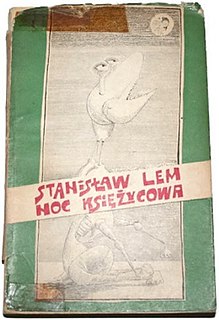
Faithful Robot is a 1961 comedy/mystery/drama science fiction TV play by Polish writer Stanisław Lem. Its first print was in 1963, in the short story collection Noc księżycowa.
The Hunt is a long unknown science fiction short story by Stanisław Lem about a robot hunted by people. It superficially resembles another Lem's short story The Hunt from Tales of Pirx the Pilot, however the two are completely different. It was written before the Pirx story, probably in late 1950s. It was found in Lem's archives and published in Przekrój magazine in 2018. An English translation was published in 2019.

The Mask is a science fiction techno horror short story by Polish writer Stanisław Lem written in 1974 and first published in literary magazine Kultura that year. It was the title story in a short story collection published in 1976 by Wydawnictwo Literackie. It is a story of an assassin android she-robot programmed both to love and to kill its human target and who gradually becomes aware of herself and her programming.
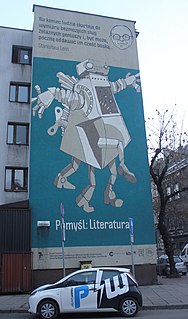
Robots of Stanisław Lem are best known from writer's series Fables for Robots (1964), written in the grotesque form of folk fairy tales, set in the universe populated by robots. In this universe there are robot kings, robot peasants, robot knights, robot scientists; a robot damsel in distress is pestered by a robot dragon, robot dogs have robot fleas, etc. The collection The Cyberiad (1965) belongs to the same grotesque cross-genre of fairy tale and science fiction. Its main protagonists are robots-"constructors" Trurl and Klapaucius, who are something of both sorcerers and engineers.










